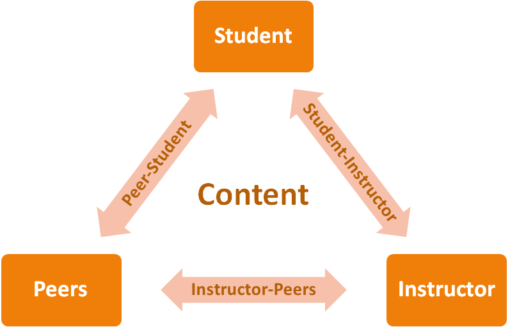Social presence is not just about being nice, friendly, or approachable. While these are important, social presence also means ensuring there’s a cohesive community of learners who engage with the content in a deep and meaningful way.

In a Community of Inquiry, communication and interaction occurs between three agents: the student, their peers, and the instructor. These three agents not only communicate with one another, they also interact with the content independently and in combination. For example, the student can engage with the content on their own (independent study), with their peers (group work), with the instructor (one-on-one explanation), or with both their peers and the instructor (class discussion).
Each of these different types of interactions requires commitment on the part of its members. A class discussion can only work when students are willing to share what’s on their mind, and group work is only effective if students work together and build off of each others’ ideas. For this to happen there needs to be a learning environment that promotes open and respectful communication.
The best way to attain this is to set the tone at the very beginning of a course by promoting the academic purposes of the learning environment you want to create. In my previous post I provide an example of what it means to truly understand something at a deep and intuitive level. This is an important point to make as students may not fully grasp what deep meaningful learning truly means. However, the post only alludes to this being a slow, intentional, social process. Although these are not obvious in the post, they could easily be included in a course introduction (either online or face-to-face).
Since the output of any interaction reflects the efforts of each and every individual involved, social presence is not only about the instructor, but the students as well. By promoting open and respectful communication, we encourage students to take risks on ideas, to listen to others, and to collaboratively build on these ideas. In short, we encourage students to put in effort. And in the end, we ensure that our students take away more than they would have otherwise.
Leave a Reply